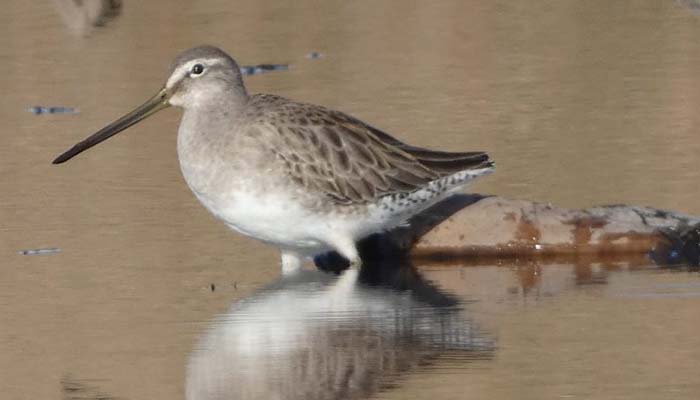
English: Long-billed
Dowitcher
Russian: Американский бекасоведный веретенник
Mongolian: Хараалжин цууцил, Хараалжин цууцаль
German: Grosser Schlammlaufer
French: Becassin a long bec
Japanese: オオハシシギ (O-hashi-shigi)
Body length:
27-30 cm.
Wing span: 42-49
cm.
Breeds in N
American and E Siberia. Vagrant to Europe; several records annually in Britain
& Ireland.
Identification:
Dowitchers are Snipe-sized, with shape, actions and plumage suggesting cross
between Snipe and Bar-tailed Godwit; very long bill, prominent supercilium,
greenish moderate-length legs and (in flight) thin white ‘slit’ up back and
prominent whitish trailing edge to wing. Typical of dowitchers is that blunt-tipped
bill is a fraction decurved distally. Given good views, identification of
juveniles straight-forward, but adult summer and adult winter difficult, often
requiring diagnostic voice to confirm. Bull lengths overlap extensively, and
useful only for extremes: twice head length or more indicates Long-billed,
about 1 ½ times head length indicates Short-billed; on Long-billed black bars
on tail-feathers broader than light bars, on Short-billed black bars narrower
than light bars (those with equal-width bars are indeterminate).
- Adult summer:
Underparts 9often except undertai-coverts) rusty-orange, including belly, with
dense spotting on foreneck and upper breast, and strong barring or transverse
blotching on breast-sides, flanks and undertail-coverts.
- Adult winter: Flank
barring and whole breast grey, with rather abrupt border against white belly.
- Juvenile:
Tertials, greater coverts and scapulars solidly dark-centred, with neat
(sometimes finely scalloped) whitish or rufous fringes (or sometimes small
internal markings near tips).